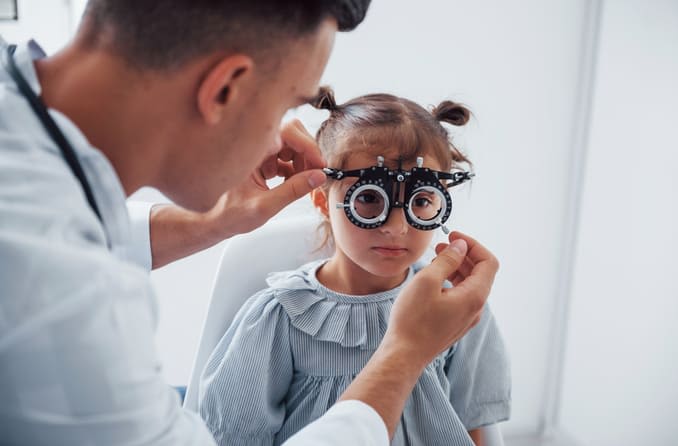What is a pediatric ophthalmologist?

A pediatric ophthalmologist is a medical doctor who specializes in children's eye health. They treat eye-related conditions in children, manage chronic disorders, prescribe medicine and perform surgery when needed.
A pediatric ophthalmologist has more extensive training, experience and education in children's vision conditions, working with children and examining children's eyes than a non-specialized eye doctor. However, they do not usually do routine eye exams.
A child may be referred to a pediatric ophthalmologist when a pediatrician, optometrist or general ophthalmologist feels there may be an eye alignment issue or other eye problem that requires specialized medical or surgical attention.
Conditions treated
A pediatric ophthalmologist manages and treats both common and uncommon childhood eye conditions.
More common eye disorders include:
Refractive errors: Nearsightedness, farsightedness and astigmatism.
Amblyopia: Commonly known as lazy eye. Early treatment of amblyopia is important to a child’s visual development.
Strabismus: Also known as crossed eyes. Strabismus occurs when there is a problem with the muscles attached to one or both eyes.
Ptosis: When one or both of the upper eyelids droop down. In severe cases, the drooping eyelid can block part of a child’s vision.
Stye or chalazion: Bumps along an eyelid caused by small bacterial infections.
Eye injuries and trauma
A pediatric ophthalmologist can also treat less common eye conditions, such as:
Congenital cataract: A child’s natural lens, located inside the eye and directly behind the pupil, is clouded at birth.
Congenital glaucoma: An abnormal buildup of fluid pressure inside the eye. Children can be born with congenital glaucoma or develop it shortly after birth.
Albinism: The body doesn’t produce enough melanin pigment, resulting in lightly colored skin and hair. Albinism can lead to several eye-related problems. [See also: Ocular albinism.]
Retinopathy of prematurity (ROP): A retinal disease that affects some babies born prematurely.
Uveitis: An inflammation of the middle layer of the eye (the uvea). Cases of uveitis are often chronic.
Fourth nerve (superior oblique) palsy: A weak eye muscle causes the eyes to become misaligned, leading to double vision.
Retinoblastoma: A rare form of eye cancer. When it’s detected early, treatment comes with a very high success rate.
Retinitis pigmentosa: A rare condition that causes the retina to slowly deteriorate over time.
Infantile nystagmus: A rare condition that causes constant or erratic eye movement.
Some doctors manage conditions that others will not. Contact your pediatric ophthalmologist’s office to make sure they can treat a certain disorder.
SEE RELATED: What is a pediatric optometrist?
What to expect
Pediatric ophthalmologists have a large arsenal of medical tests they can perform to diagnose and manage the conditions listed above, in addition to others.
After the doctor gets a general idea of your child’s condition, they may utilize one or more of the following tests:
Vision screening and evaluation
The doctor will use several tests to gauge how well your child can see. If your child will benefit from wearing glasses, the doctor will provide a vision prescription.
Pupil dilation
Some exams require the child’s pupils to be opened wider, so the doctor can see more of the inner eye. Pupils are dilated using eye drops, and your child’s vision will be blurry for several hours afterward. Pupil dilation does not cause any pain, but their eyes will be sensitive to light for a little while.
Eye alignment exams
A doctor can perform testing to diagnose and determine treatment for conditions such as strabismus and amblyopia.
Exams under anesthesia
Some eye tests are difficult or impossible to perform while a child is awake and alert. These advanced tests need to be done under anesthesia, meaning your child will be asleep.
Pediatric ophthalmologists can also handle any treatment needed to improve or relieve the state of your child’s eye disorder. Depending on the diagnosed condition, treatment options may include:
Prescription eyeglasses or contact lenses
Special glasses or eye patches (for treatment of amblyopia)
Lubricating eye drops
Medicated eye drops
Oral medication
Surgery
When to visit a pediatric ophthalmologist
Start by scheduling a comprehensive eye exam for your child with an optometrist. If they think your child should be evaluated by a pediatric ophthalmologist, they will refer you to one.
Depending on your insurance, you may need a referral from an optometrist, pediatrician or family physician before your insurance provider will cover your appointment.
Page published on Monday, December 14, 2020




